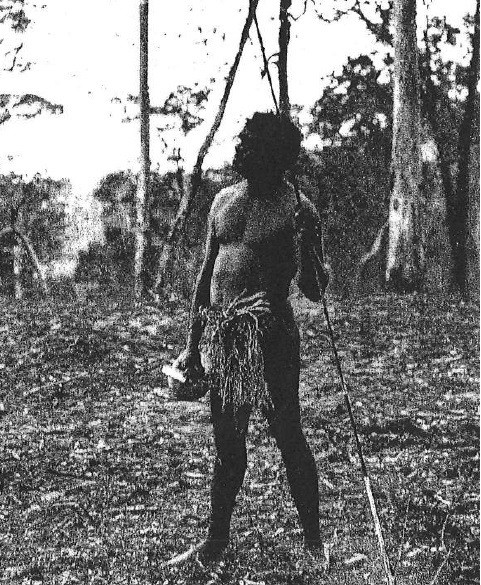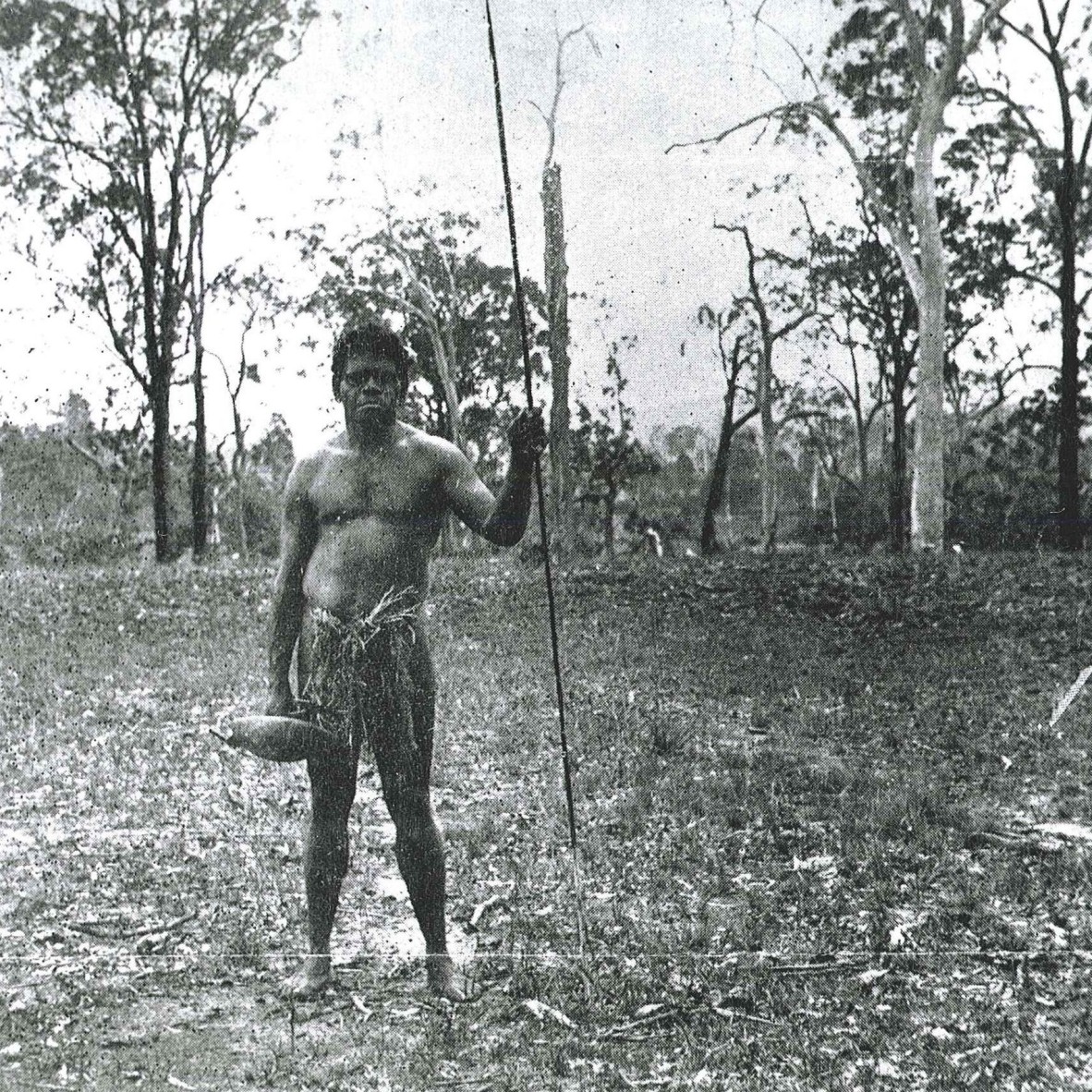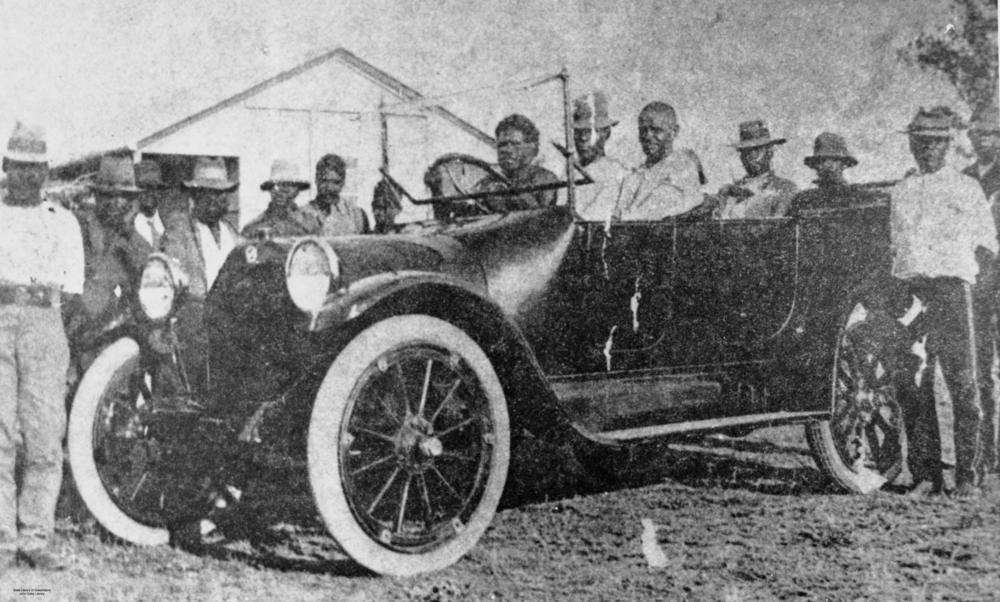Jerry Jerome (Aboriginal boxer) 1874-1943
By Tania Schafer - Librarian, State Library of Queensland | 19 October 2020
Cultural Care statement (disclaimer)
Users are advised that this Aboriginal and/or Torres Strait Islander material may contain culturally sensitive imagery and descriptions which may not normally be used in certain public or community contexts. Annotation and terminology which reflects the creator's attitude or that of the era in which the item was created may be considered inappropriate today. This material may also contain images, voices or names of deceased persons.
Jerry Jerome (1874-1943) was born on 24 May 1874 at Jimbour Station, 16 km north of Dalby, Queensland. He was the son of Wollon Charlie, an Aboriginal labourer, and his wife Guli. In 1906 Jerry married Alice Davis at Dalby.
Jerry was from the Yiman Aboriginal group and was a renown horseman, athlete, and boxer. In 1908 he officially commenced boxing at “The Pines”, a park near Warra. It was said that Jerry did not want any money for the fight, only a new horse, saddle, and bridle.
Jerry lived during the 'Control of Aboriginal Protection Act', which meant that his movement and life were restricted to the control of the Chief Protector. Before his fourth fight with Fred Booth, Jerry was arrested in Warra, due to the Protection Act. However, he was released in time for the Toowoomba fight where he was knocked out, which had the crowds convinced that he had been drugged. In 1908 a Dalby citizen applied successfully for Jerry Jerome’s exemption on the spurious ground that he was a ‘half caste’, in order to be removed from the controlled native listing, which would allow him to pursue a sporting career.
Jerry Jerome twice defeated Frenchman Ercole de Balzac and Britain’s middleweight champion, Jim Sullivan. He confused his opponents with his unorthodox southpaw stance, his dancing and weaving tactics (which greatly amused the crowds) and his dazzling bursts of hurricane-like speed punching. In his prime Jerry Jerome weighed 11 stone, 8 pounds (73 kgs) and was 5 foot, 8 inches tall (172 cms).
Jerry Jerome was referred to as the ‘Warra Cyclone’ and was an amazing athlete with many stories about his life such as his first fight down at the riverbank with Tom Francis. He was also well know for his cross-country running including a story where he ran from the station to Kogan, along flooded creeks and rivers to get help for Bill Francis, who was accidentally shot through the knee. Jerry Jerome had even competed in a race against a horse and jockey at Warra.
In 1912 Jerry fought Black Paddy, champion of Western Australia, which was possibly the first contest between two Aboriginal professional boxers. Black Paddy was born in Murchison at Queensland and later moved to Cue, Western Australia. In August 1912, in Brisbane to a crowd of five thousand spectators, Jerry Jerome defeated Black Paddy in a sixteen round boxing match. In the same year Jerry was awarded the Australian middleweight boxing champion.
Jerry Jerome was noted in the newspaper as being a gambler who would bet on two flies crawling up a wall, and had a fondness for the game two-up.
Early in the past year, although such a proceeding had never previously been heard of in connection with the protection of Aboriginals, the Department became impressed with the necessity for taking some control of the affairs of the Aboriginal professional boxer, Jerry Jerome. Beyond persuading him to bank a few pounds after each contest, which he almost immediately drew out again, no organised action had been taken to control his affairs. But when information began to be received of the large sums of money this boy was winning, and of the extravagance with which it was handled and spent, it appeared to be the Department's duty to interfere, and the Honourable the Minister accordingly gave instructions for all his business to be done under the supervision of this office. At the end of the year, after less than nine months' work, he had £1,000 6s. l0d. saved, and satisfactory arrangements have also been made for the care of his wife and family. It is intended to exercise a strict supervision of the aboriginal's affairs until he retires from the ring, when he will be advised to safely invest the money saved and live on the proceeds.
The National Film and Sound Archive (NFSA) shared footage, 'On with the Gloves' of Jerry Jerome during a historic fight with Pat Bradley in Brisbane 1915 but this is believed to be incorrect, Jerry Jerome is actually fighting Arthur Cripps on the 10th August 1910. This was the first time an Aboriginal man was allowed to fight for a weight division in Australia and ended after fifteen rounds with Arthur Cripps winning on points.
On With The Gloves, National Film and Sound Archive. Skip to 9.41 minutes to title page Middleweight Contest Jerome vs Bradley, Brisbane 1915.
The State Library of Queensland holds three photographs of Jerry Jerome. The images are from the Aboriginal Copy Print collection held at the John Oxley Library, but the locations need to be confirmed.

Jerry Jerome, Samford District 1915, Negative 62956, John Oxley Library, State Library of Queensland

Jerry Jerome, Russell Island, Negative 107426, John Oxley Library, State Library of Queensland

Jerry Jerome driving his car with friends, Taroom Settlement, 1925, Negative number 108905, John Oxley Library, State Library of Queensland
This image of Jerry Jerome in a car is well known by Aboriginals for 'inciting all others (Aborigines) to refuse to work unless paid cash for it' which the Chief Protector, J W Bleakley claimed "this moneyed gentleman 'took a 'ean advantage' to obstruct discipline and defy authority'". His audacity was spending his winnings on himself. This caused Jerome's removal in 1914 from Taroom, shown in the Centre for Indigenous family history studies (Queensland – Removals - Queensland removals 1912-1939) Aboriginal Removal Correspondence 1912-1939 Home Office, Registers of Letters Received for Removal in 1914 (record held at the Queensland State Archives).
Jerry Jerome fought 58 boxing battles, 35 were wins and 23 were losses. In 1915 at the age of 41 Jerry resigned from boxing.
In 1919 Jerry Jerome was a resident on Fraser Island where heartbreakingly he lost his his daughter Myrtle. The young girl was stricken with illness and taken to the Maryborough General Hospital where she died on 23rd August 1919.
Jerry Jerome died on 27 September 1943 at Cherbourg Aboriginal mission penniless and is assumed to be buried at Murgon cemetery. At the time of his death Jerome was a white-haired, bushy-whiskered, toothless old man in his seventies.
Approximately 20 of Jerome's first-class fights netted him something in the vicinity of £5000. Worth over $500,000 in today's money according to the Reserve Bank of Australia Pre-Decimal Inflation Calculator. Reckless handling of his share of the purse resulted in the Chief Protector of Aborigines taking over control of his interests. His biggest purse was £575 for his fight with David Smith at Sydney Stadium under the direction of Snowy” Baker, worth over $71,000 today. Snowy Baker once said: “If old Jerome would ever keep as fit as he is capable of being made, he would be the greatest middle-weight fighter in the world”. With his money all gone he spent his last years coaching promising Aboriginal boxers and refereeing their bouts. Jerome was survived by his three sons and one of his two daughters.
Jerome was the 2008 Inductee for the Australian National Boxing Hall of Fame Old Timers category.
Jerry Jerome's Boxing Career - Wins and Losses
1907-10
- Won, Ned Foran
- Won, Abe Williams
- Won, Sam Cooney
- Won, Max Pardella
- Lost, K.O. Fred Booth
- Won, Chewey Williams
- Won, Red Wilson
- Won, Tom Reidy
- Lost, Arthur Cripps
- Lost, Ted Whiting
1911
- Lost, “Cyclone” Johnny Thompson
- Won, Tom Jones
- Lost, Bill Rudd
- Lost, Ted Whiting
- Won, Pat Regan
- Won,Charlie Godfrey
- Won, Chewey Williams
- Won, Albert Scanlon.
1912
- Won, Chewey Williams
- Won, Terry Keller
- Won, Black Paddy
- Won, Charlie Godfrey
- Won, Bill Rudd
- Won, Ted Whiting
- Lost, Les. O’Donnell
- Lost, Roy Kenny
- Won, Roy Kenny
- Lost, Les O’Donnell
- Won, Ted Whiting.
1913
- Won, Ercole De Balzac
- Won, Arthur Cripps
- Won, Ercole De Balzac
- Won, Bill Souter; Lost Dave Smith
- Won, Ed. Williams
- Won, Roy Kenny
- Won, Bill Souter
- Won, Harry Mansfield
- Won, Jack Cordell
- Won, Harry Mansfield
- Lost, Pat Bradley
- Won, Jim Sullivan
- Lost, Les O’Donnell
- Won, Tim Land
- Won, Tim Land.
1914
- Lost, Jules Donberg
- Won, Charlie Godfrey
- Lost, Eddie McGoorty
- Lost, Jules Donberg
1915
- Won, Arthur Evenden
- Won, Fred Storbeck
- Lost, Les O’Donnell
- Won, Walter Coffey
- Lost, Albert Llyd
- Lost, Billy McNab
- Lost, Jack Darcy
- Won, Les Gleeson
- Lost, Brillo Campbell
Bibliography Jerry Jerome:
- Australian Dictionary of Biography, Jerry Jerome (1874 - 1943)
- Queensland Protectors Report for 1908, page. 15
- Queensland Protectors Report for 1913, page. 4
- Tatz, C. Obstacle race, 1995, p. 119-124, p. 25, 96, 97, 99, 115, 116, 349, 369, port.
- Cherbourg Anniversary Organising Committee, Barambah, Cherbourg. 1904 - 1979. Pamphlet
- Holt, Albert. Forcibly removed, Broome, W.A. : Magabala Books, 2001, pages 87-88 & 67
- Aboriginal history Vol. 20 (1996), p. 1-23, port. Reference to Jerry is on page 5.
- Clements, J.C. ed. Woorabinda 1927-1977 : Golden Jubilee Year. 1977 : page 4
- Corris, P. Lords of the Ring (Syd, 1980)
- Tatz, C. Aborigines in Sport (Adelaide, 1987) Chapter five - the Glory Sport page 38 has an image of Jerry Jerome and page 44 has a small summary.
- Yiman People
- Trove: JERRY JEROME, (1953, January 4). Truth (Sydney, NSW : 1894 - 1954), p. 12.
- Trove: JERRY JEROME, Brisbane Telegraph (Qld. : 1948 - 1954) 24 December 1949: 4
- Trove: JERRY JEROME, Truth (Brisbane, Qld. : 1900 - 1954) 11 January 1953: 16.
- Trove: 'JERRY' JEROME (1913, April 10). The Daily Telegraph (Sydney, NSW : 1883 - 1930), p. 8. Retrieved June 18.
- Trove: OBITUARY OF JERRY JEROME DAUGHTER MYRTLE (1919, August 25). Maryborough Chronicle, Wide Bay and Burnett Advertiser (Qld. : 1860 - 1947), p. 3.
- Trove: 1914 'EVENTS OF THE DAY', The Evening Echo (Ballarat, Vic. : 1914 - 1918), 19 March, p. 2. (SECOND EDITION).
- Trove: JEROME HEATS BLACK PADDY. (1912, August 15). The Maitland Daily Mercury (NSW : 1894 - 1939), p. 7.
- Trove: 1946 'Gave Me Back My 10/-', News (Adelaide, SA : 1923 - 1954), 23 February, p. 5.
- Trove: FAMOUS ABO. FIGHTER (1943, October 23). Smith's Weekly (Sydney, NSW : 1919 - 1950), p. 19.
- Trove: OBITUARY. (1919, August 25). Maryborough Chronicle, Wide Bay and Burnett Advertiser (Qld. : 1860 - 1947), p. 3.
This material contains Aboriginal and/or Torres Strait Islander content, and has been made available in accordance with State Library of Queensland’s Aboriginal and Torres Strait Islander Collections Commitments.
Comments
Your email address will not be published.
We welcome relevant, respectful comments.